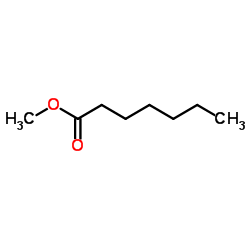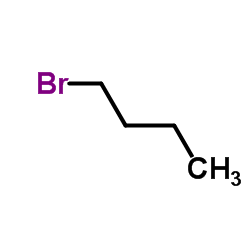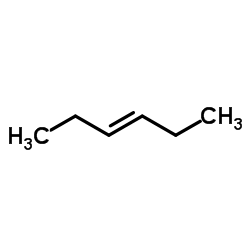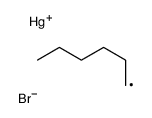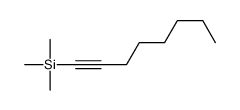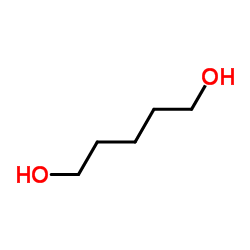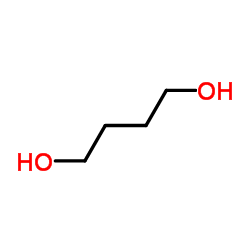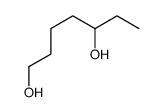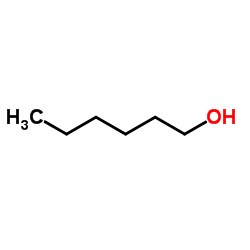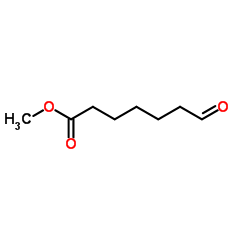106-73-0
| 中文名 | 庚酸甲酯 |
|---|---|
| 英文名 | Methyl heptanoate |
| 中文别名 |
甲基庚酸
甲基庚酸酯 |
| 英文别名 |
hexane-1-carboxylic acid methyl ester
n-heptanoic acid methyl ester Methyl heptanoate Heptanoic acid, methyl ester Methyl amyl acetate Methyl heptylate Methyl heptylate (natural) methyl 3-(R)-(n-butyl)-propionate Heptanoic acid methyl ester Methyl oenanthylate EINECS 203-428-8 MFCD00009537 Methyl n-heptylate Methyl heptoate Methyl enanthate |
| 密度 | 0.9±0.1 g/cm3 |
|---|---|
| 沸点 | 171.0±3.0 °C at 760 mmHg |
| 分子式 | C8H16O2 |
| 分子量 | 144.211 |
| 闪点 | 52.8±0.0 °C |
| 精确质量 | 144.115036 |
| PSA | 26.30000 |
| LogP | 2.83 |
| 外观性状 | 无色至浅黄色液体 |
| 蒸汽压 | 1.4±0.3 mmHg at 25°C |
| 折射率 | 1.413 |
| 储存条件 | 室温,干燥 |
| 稳定性 | 易燃,遇明火、高热易引起燃烧,与氧化剂可发生反应。 |
| 分子结构 | 1、 摩尔折射率:40.88 2、 摩尔体积(cm3/mol):164.0 3、 等张比容(90.2K):375.1 4、 表面张力(dyne/cm):27.3 5、 介电常数: 6、 偶极距(10-24cm3): 7、 极化率:16.20 |
| 计算化学 | 1.疏水参数计算参考值(XlogP):无 2.氢键供体数量:0 3.氢键受体数量:2 4.可旋转化学键数量:6 5.互变异构体数量:无 6.拓扑分子极性表面积26.3 7.重原子数量:10 8.表面电荷:0 9.复杂度:89.3 10.同位素原子数量:0 11.确定原子立构中心数量:0 12.不确定原子立构中心数量:0 13.确定化学键立构中心数量:0 14.不确定化学键立构中心数量:0 15.共价键单元数量:1 |
| 更多 | 1. 性状:无色液体、有香味。 2. 相对密度(g/mL,20/4℃):0.8815 3. 相对密度(25℃,4℃):0.871230 4. 熔点(ºC):-56 5. 沸点(ºC,常压):172 6. 沸点(ºC, mmHg):未确定 7. 折射率(20ºC):1.4152 8. 闪点(ºC):52 9. 气相标准燃烧热(焓)(kJ·mol-1):-4919.25 10. 气相标准声称热(焓)( kJ·mol-1) :-515.47 11. 液相标准燃烧热(焓)(kJ·mol-1):-4867.62 12. 液相标准声称热(焓)( kJ·mol-1):-567.10 13. 燃烧热(KJ/mol):未确定 14. 临界温度(ºC):354.85 15. 临界压力(KPa):未确定 16. 油水(辛醇/水)分配系数的对数值:未确定 17. 爆炸上限(%,V/V):未确定 18. 爆炸下限(%,V/V):未确定 19. 溶解性:与乙醇、乙醚、苯、氯仿混溶,微溶于水。 |
Synonym:Heptanoic Acid, Methyl Ester; Methyl Heptanoate Section 2 - COMPOSITION, INFORMATION ON INGREDIENTS
Risk Phrases: 10 Section 3 - HAZARDS IDENTIFICATION EMERGENCY OVERVIEW
Flammable. Potential Health Effects Eye: May cause eye irritation. May cause chemical conjunctivitis and corneal damage. Skin: May cause skin irritation. May cause cyanosis of the extremities. Ingestion: May cause gastrointestinal irritation with nausea, vomiting and diarrhea. Ingestion of large amounts may cause CNS depression. May cause cardiac arrhythmias, hypotension, and albuminuria. Inhalation: May cause respiratory tract irritation. Aspiration may lead to pulmonary edema. Vapors may cause dizziness or suffocation. May cause cardiac abnormalities. Inhalation at high concentrations may cause CNS depression and asphixiation. May cause burning sensation in the chest. Chronic: Effects may be delayed. Section 4 - FIRST AID MEASURES Eyes: Immediately flush eyes with plenty of water for at least 15 minutes, occasionally lifting the upper and lower eyelids. Get medical aid. Skin: Get medical aid. Flush skin with plenty of water for at least 15 minutes while removing contaminated clothing and shoes. Wash clothing before reuse. Ingestion: Never give anything by mouth to an unconscious person. Get medical aid. Do NOT induce vomiting. If conscious and alert, rinse mouth and drink 2-4 cupfuls of milk or water. Inhalation: Remove from exposure and move to fresh air immediately. If not breathing, give artificial respiration. If breathing is difficult, give oxygen. Get medical aid. Do NOT use mouth-to-mouth resuscitation. Notes to Physician: Section 5 - FIRE FIGHTING MEASURES General Information: As in any fire, wear a self-contained breathing apparatus in pressure-demand, MSHA/NIOSH (approved or equivalent), and full protective gear. Vapors may form an explosive mixture with air. Vapors can travel to a source of ignition and flash back. During a fire, irritating and highly toxic gases may be generated by thermal decomposition or combustion. Will burn if involved in a fire. Use water spray to keep fire-exposed containers cool. Containers may explode in the heat of a fire. Flammable liquid and vapor. Vapors may be heavier than air. They can spread along the ground and collect in low or confined areas. Runoff from fire control or dilution water may cause pollution. Extinguishing Media: For small fires, use dry chemical, carbon dioxide, water spray or alcohol-resistant foam. For large fires, use water spray, fog, or alcohol-resistant foam. Use water spray to cool fire-exposed containers. Water may be ineffective. Do NOT use straight streams of water. Section 6 - ACCIDENTAL RELEASE MEASURES General Information: Use proper personal protective equipment as indicated in Section 8. Spills/Leaks: Absorb spill with inert material (e.g. vermiculite, sand or earth), then place in suitable container. Avoid runoff into storm sewers and ditches which lead to waterways. Clean up spills immediately, observing precautions in the Protective Equipment section. Remove all sources of ignition. Use a spark-proof tool. Provide ventilation. A vapor suppressing foam may be used to reduce vapors. Section 7 - HANDLING and STORAGE Handling: Wash thoroughly after handling. Use with adequate ventilation. Ground and bond containers when transferring material. Use spark-proof tools and explosion proof equipment. Avoid contact with eyes, skin, and clothing. Empty containers retain product residue, (liquid and/or vapor), and can be dangerous. Keep container tightly closed. Keep away from heat, sparks and flame. Avoid ingestion and inhalation. Do not pressurize, cut, weld, braze, solder, drill, grind, or expose empty containers to heat, sparks or open flames. Storage: Keep away from sources of ignition. Store in a tightly closed container. Store in a cool, dry, well-ventilated area away from incompatible substances. Flammables-area. Section 8 - EXPOSURE CONTROLS, PERSONAL PROTECTION Engineering Controls: Facilities storing or utilizing this material should be equipped with an eyewash facility and a safety shower. Use process enclosure, local exhaust ventilation, or other engineering controls to control airborne levels. Exposure Limits CAS# 106-73-0: Personal Protective Equipment Eyes: Wear appropriate protective eyeglasses or chemical safety goggles as described by OSHA's eye and face protection regulations in 29 CFR 1910.133 or European Standard EN166. Skin: Wear appropriate protective gloves to prevent skin exposure. Clothing: Wear appropriate protective clothing to prevent skin exposure. Respirators: A respiratory protection program that meets OSHA's 29 CFR 1910.134 and ANSI Z88.2 requirements or European Standard EN 149 must be followed whenever workplace conditions warrant respirator use. Section 9 - PHYSICAL AND CHEMICAL PROPERTIES Physical State: Liquid Color: clear, colorless Odor: Not available. pH: Not available. Vapor Pressure: Not available. Viscosity: Not available. Boiling Point: 172 -173.4 deg C @ 760.00mmHg Freezing/Melting Point: Not available. Autoignition Temperature: Not available. Flash Point: 52 deg C ( 125.60 deg F) Explosion Limits, lower: Not available. Explosion Limits, upper: Not available. Decomposition Temperature: Solubility in water: Specific Gravity/Density: .8700g/cm3 Molecular Formula: C8H16O2 Molecular Weight: 144.21 Section 10 - STABILITY AND REACTIVITY Chemical Stability: Stable under normal temperatures and pressures. Conditions to Avoid: Incompatible materials, ignition sources, excess heat, strong oxidants. Incompatibilities with Other Materials: Oxidizing agents, strong bases. Hazardous Decomposition Products: Carbon monoxide, irritating and toxic fumes and gases, carbon dioxide. Hazardous Polymerization: Has not been reported Section 11 - TOXICOLOGICAL INFORMATION RTECS#: CAS# 106-73-0: MJ2297500 LD50/LC50: CAS# 106-73-0: Oral, rat: LD50 = >5 gm/kg; Skin, rabbit: LD50 = >5 gm/kg. Carcinogenicity: Methyl Enanthate - Not listed by ACGIH, IARC, or NTP. Other: See actual entry in RTECS for complete information. Section 12 - ECOLOGICAL INFORMATION Section 13 - DISPOSAL CONSIDERATIONS Dispose of in a manner consistent with federal, state, and local regulations. Section 14 - TRANSPORT INFORMATION IATA Shipping Name: FLAMMABLE LIQUID, N.O.S.* Hazard Class: 3 UN Number: 1993 Packing Group: II IMO Shipping Name: FLAMMABLE LIQUID, N.O.S. Hazard Class: 3.2 UN Number: 1993 Packing Group: II RID/ADR Shipping Name: FLAMMABLE LIQUID, N.O.S. Hazard Class: 3 UN Number: 1993 Packing group: II Section 15 - REGULATORY INFORMATION European/International Regulations European Labeling in Accordance with EC Directives Hazard Symbols: Not available. Risk Phrases: R 10 Flammable. Safety Phrases: S 9 Keep container in a well-ventilated place. S 16 Keep away from sources of ignition - No smoking. S 33 Take precautionary measures against static discharges. WGK (Water Danger/Protection) CAS# 106-73-0: No information available. Canada CAS# 106-73-0 is listed on Canada's DSL List. CAS# 106-73-0 is not listed on Canada's Ingredient Disclosure List. US FEDERAL TSCA CAS# 106-73-0 is listed on the TSCA inventory. SECTION 16 - ADDITIONAL INFORMATION N/A |
|
毒理学数据: 1、急性毒性:大鼠经口LD50:>5mg/kg;兔子经皮肤接触LD50:>5mg/kg; CHEMICAL IDENTIFICATION
HEALTH HAZARD DATAACUTE TOXICITY DATA
|
| 符号 |

GHS02 |
|---|---|
| 信号词 | Warning |
| 危害声明 | H226 |
| 警示性声明 | P210-P370 + P378 |
| 个人防护装备 | Eyeshields;full-face respirator (US);Gloves;multi-purpose combination respirator cartridge (US);type ABEK (EN14387) respirator filter |
| 危害码 (欧洲) | Xi:Irritant; |
| 风险声明 (欧洲) | R36/37/38 |
| 安全声明 (欧洲) | S16-S26-S36 |
| 危险品运输编码 | UN 3272 3/PG 3 |
| WGK德国 | 2 |
| RTECS号 | MJ2297500 |
| 包装等级 | III |
| 危险类别 | 3.2 |
| 海关编码 | 2915900090 |
| 上游产品 10 | |
|---|---|
| 下游产品 8 | |
| 海关编码 | 2915900090 |
|---|---|
| 中文概述 | 2915900090. 其他饱和无环一元羧酸及其酸酐(酰卤、过氧)化物、过氧酸及其卤化、硝化、磺化、亚硝化衍生物. 增值税率:17.0%. 退税率:9.0%. 监管条件:AB(入境货物通关单,出境货物通关单). 最惠国关税:5.5%. 普通关税:30.0% |
| 申报要素 | 品名, 成分含量, 用途 |
| 监管条件 | A.入境货物通关单 B.出境货物通关单 |
| 检验检疫 | R.进口食品卫生监督检验 S.出口食品卫生监督检验 M.进口商品检验 N.出口商品检验 |
| Summary | 2915900090 other saturated acyclic monocarboxylic acids and their anhydrides, halides, peroxides and peroxyacids; their halogenated, sulphonated, nitrated or nitrosated derivatives VAT:17.0% Tax rebate rate:9.0% Supervision conditions:AB(certificate of inspection for goods inward,certificate of inspection for goods outward) MFN tariff:5.5% General tariff:30.0% |


